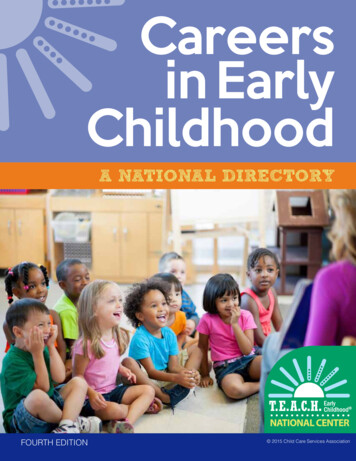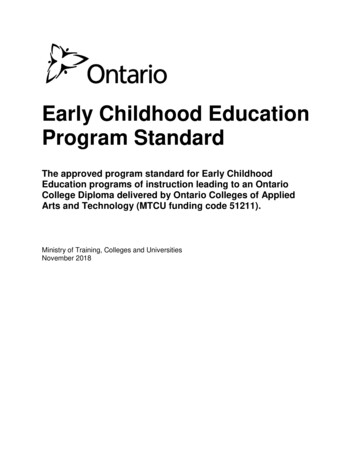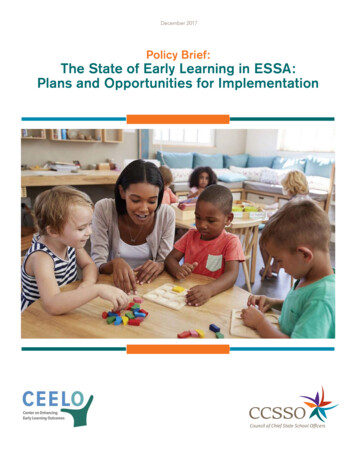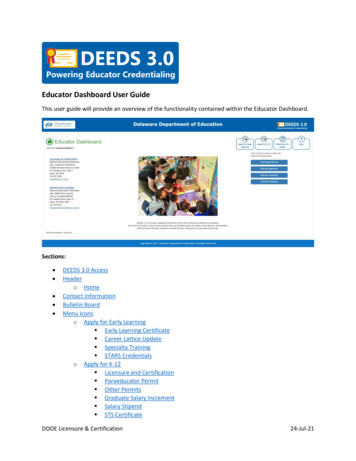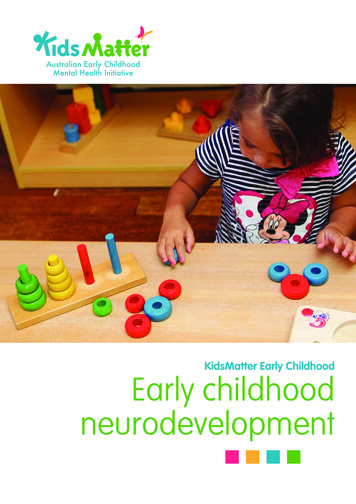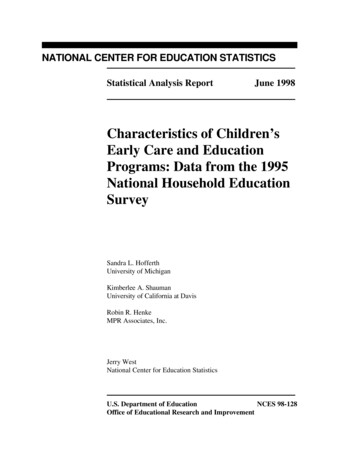
Transcription
NATIONAL CENTER FOR EDUCATION STATISTICSStatistical Analysis ReportJune 1998Characteristics of Children’sEarly Care and EducationPrograms: Data from the 1995National Household EducationSurveySandra L. HofferthUniversity of MichiganKimberlee A. ShaumanUniversity of California at DavisRobin R. HenkeMPR Associates, Inc.Jerry WestNational Center for Education StatisticsU.S. Department of EducationNCES 98-128Office of Educational Research and Improvement
U.S. Department of EducationRichard W. RileySecretaryOffice of Educational Research and ImprovementRicky T. TakaiActing Assistant SecretaryNational Center for Education StatisticsPascal D. Forgione, Jr.CommissionerThe National Center for Education Statistics (NCES) is the primary federal entity for collecting, analyzing, and reporting data related to education in the United States and other nations. It fulfills a congressional mandate to collect, collate, analyze, and report full and complete statistics on the condition ofeducation in the United States; conduct and publish reports and specialized analyses of the meaning andsignificance of such statistics; assist state and local education agencies in improving their statistical systems; and review and report on education activities in foreign countries.NCES activities are designed to address high priority education data needs; provide consistent, reliable,complete, and accurate indicators of education status and trends; and report timely, useful, and highquality data to the U.S. Department of Education, the Congress, the states, other education policymakers, practitioners, data users, and the general public.We strive to make our products available in a variety of formats and in language that is appropriate to avariety of audiences. You, as our customer, are the best judge of our success in communicating information effectively. If you have any comments or suggestions about this or any other NCES product orreport, we would like to hear from you. Please direct your comments to:National Center for Education StatisticsOffice of Educational Research and ImprovementU.S. Department of Education555 New Jersey Avenue NWWashington, DC 20208-5574June 1998The NCES World Wide Web Home Page address ishttp://ed.gov/NCESSuggested CitationU.S. Department of Education, National Center for Education Statistics. Characteristics of Children’sEarly Care and Education Programs: Data from the 1995 National Household Education Survey, NCES98-128, by Sandra L. Hofferth, Kimberlee A. Shauman, Robin R. Henke, and Jerry West. Washington,D.C.: 1998.Content Contact:Jerry West(202) 219-1574
AcknowledgmentsA number of MPR Associates staff members contributed to the production of this report.Andrea Livingston and Karyn Madden edited the text, tables, and figures. Mary Sukkestad, DonEike, and Francesca Tussing formatted the tables and figures and completed the report’s layout,and Barbara Kridl supervised the overall production. The authors greatly appreciate their work.In addition, the authors are grateful for the thoughtful comments and suggestions providedby reviewers of the report. At the National Center for Education Statistics (NCES), the followingstaff read and commented on the report: Michael Cohen of the Statistical Standards and ServicesGroup, Laura Lippman and Jeffrey Owings of the Data Development and Longitudinal StudiesGroup, and Mary Rollefson of the Surveys and Cooperative Systems Group. In addition to NCESstaff, Ellen Bradburn of the Education Statistics Support Institute, Sue Bredekamp of the National Association for the Education of Young Children and James Griffin and Donna Hinkle ofthe National Institute on Early Childhood Development and Education also reviewed this publication. Their suggestions substantially improved the quality of the publication; any errors remainingare the sole responsibility of the authors.iii
Executive SummaryThis report examines the characteristics of the care and education children receive on aregular basis before they enter school. In doing so, it addresses four questions that have surfacedwith the prevalence of nonparental child care and children’s increased participation in early childhood education programs: Were children at greater risk of school failure1 less likely than other children to be ineducation programs or nonparental care arrangements that facilitate child development? Where did parents get information about their child care arrangements? In particular,was the cost of child care a good indicator of its quality? What were parents’ preferences regarding nonparental child care and early childhoodeducation programs? Were parents’ preferences reflected in the types and characteristics of their children’sprimary nonparental care arrangements or early childhood education programs? Didparents get what they wanted?To address these issues, this report focuses on various characteristics of child care arrangements that can be categorized into two groups: those that have been associated with children’sdevelopment, and those that stem from parental concerns other than child development, such asstaying within budgets or maintaining work schedules. Of the former, this study includes the following: the amount of time children spend in nonparental care; the number of different nonparental arrangements in which a given child is cared for; the ratio of children to staff; whether the teacher or child care provider was trained in child development; whether the care arrangement or education program offered services such as health orpsychological screening;1Children are defined as “educationally disadvantaged” or “at risk” if they have one of several characteristics that have tradi-tionally been associated with school failure or developmental difficulties, such as being from a low-income or single parentfamily.v
EXECUTIVE SUMMARY whether parent involvement in the program was encouraged; and whether the teacher or care provider spoke English to the child most of the time.Of the latter, child care characteristics that are relevant to parental concerns independent ofchild development, this study includes the travel time between the program and home, its cost,and the availability of sick child care.The data from which the findings are drawn were collected as part of the 1995 NationalHousehold Education Survey (NHES:95), in which a nationally representative sample of the parents of children who were age 10 or younger and in third grade or below were interviewed. Thesurvey not only obtained detailed information about children’s nonparental care arrangements andearly childhood education programs, but also gathered information about the parents and childrenthemselves. The focus of this report is on children who were under age 6 and were not yet enrolled in kindergarten, whom we refer to as preschool children.WERE CHILDREN AT RISK OF SCHOOL FAILURE LESS LIKELY THANOTHER CHILDREN TO BE IN PROGRAMS OR ARRANGEMENTS THATFACILITATE CHILD DEVELOPMENT?In 1995, 59 percent of preschool children were in some type of nonparental arrangementson a regular basis.2 Twenty-eight percent of preschoolers were in full-time nonparental care (i.e.,35 or more hours per week). Although infants were less likely than older children to be in nonparental care, among those children in regular nonparental care, younger children spent more hoursper week in such arrangements than did older children. Furthermore, children at greater risk ofschool failure spent more time per week in nonparental care, on average, than did other children.Being cared for in more than one nonparental care arrangement at a time may be detrimentalto infants and very young children, who may require consistent caregiving in order to form theattachments necessary for later development. The NHES:95 data indicate that infants were rarelycared for in such arrangements, although the incidence increased with the child’s age. The use ofmore than one nonparental care arrangement at a time was more common among children atgreater risk of school failure than among other children.2For simplicity’s sake, from this point, “nonparental care arrangement” or “nonparental arrangement” is used to denote eithernonparental child care or an early childhood education program.vi
EXECUTIVE SUMMARYFamily income, a key risk factor, was strongly associated with the type of primary nonparental care children received. Compared with those of children from higher income families, theprimary arrangements of children from low-income families were more likely to be Head Startprograms, family child care, or relative care, rather than other center-based programs. The age ofthe child and the employment status of the mother were also associated with the type of primarychild care arrangement. For example, older children were more likely to be in center-based care,and younger children in informal care arrangements (family child care, relative, or in-home care).Moreover, children of employed mothers were more likely to be in family child care, in-homecare, or relative care and less likely to be in Head Start as their primary arrangement, than childrenof mothers who were not employed. Similarly, among children in multiple nonparental arrangements, informal arrangement combinations were more common among young children, whereascombinations of formal arrangements were more common among older children.The characteristics of children’s nonparental care varied with the type of care they received.Children who spent most of their time in in-home child care or in family child care were cared forwith fewer children than those in other nonparental care arrangements, were more likely to have acare provider who spoke a language other than English with them, and were more likely to becared for by their nonparental care provider when they were sick. Also, children in family childcare were more likely to live within 10 minutes of their primary nonparental care provider thanchildren cared for by relatives or enrolled in center-based programs. The cost of the primary nonparental care arrangement was highest for children in in-home and non-Head Start center-basedcare. Finally, formal center-based programs were more likely than other primary arrangements tooffer trained child care providers and services such as developmental screening and health examinations.Likewise, the attributes of children’s primary nonparental care varied according to severalfamily factors, after adjusting for other child and family characteristics and type of primary arrangement. Not surprisingly, children from families with incomes of more than 50,000 were inmore expensive care than children from families with incomes of 15,000 or less. Children ofmothers not in the work force were less likely to be enrolled in primary arrangements that offeredsick child care and were more likely to be enrolled in programs close to their homes than childrenof mothers who were working or looking for work. In addition, the primary nonparental care providers of Hispanic children, children of other non-black minority racial–ethnic backgrounds, andchildren in predominately non-English-speaking households were much less likely to speakvii
EXECUTIVE SUMMARYEnglish with them than those of white, non-Hispanic children and children in English-speakinghouseholds, respectively. Child/staff ratios and the training of the care provider were not relatedto the characteristics of the parents; however, ratios were related to child age, and ratios andtraining were both related to the type of child care arrangement.Based upon the characteristics measured in this study, children at greater risk of school failure did not receive care or education of lower quality than did other children. Adjusting for otherchild and family characteristics and type of primary arrangement, children from low-income families were more likely than those from high-income families to have access to health-related services and sick child care through the primary arrangement. Several other risk factors, such ashaving a disability, not speaking English at home, being from a large family, and having a motherwho had not received a high school diploma, were also associated with receiving more services.Considering the access to health-related services through their primary arrangements alone, children at greater risk of school failure were more likely to receive such services than other children.With respect to other child care characteristics associated with positive outcomes for children—the child/staff ratio, whether the care provider or teacher had training in child development,whether parent involvement was encouraged, and whether the child care provider spoke Englishwith the child most of the time—there were no consistent differences between children at greaterrisk of school failure and other children.WHERE DID PARENTS GET INFORMATION REGARDING CHILD CAREARRANGEMENTS?More than half of children’s parents reported that friends were their source of informationabout their primary nonparental child care arrangements. Parents of older children were morelikely to learn about the arrangement through a school, and employed mothers were more likely todo so from an employer.Parents could not judge program characteristics by program cost. For example, they did notobtain a lower ratio of children to staff or more services when paying more, even after adjustingfor the age of the child and other factors. The only child development-related care characteristicassociated with price was provider training; primary arrangements with trained care providers costparents more. Parents also paid more when care was close to home.viii
EXECUTIVE SUMMARYWHAT WERE PARENTS’ PREFERENCES REGARDING CHILD CAREARRANGEMENTS?Parents’ preferences for child care characteristics were consistent with child developmentexperts’ opinions on the characteristics that matter to children’s development. Parents were morelikely to report that having a small number of children and a trained provider were important inchoosing a child care arrangement than to say that cost and convenience were important.For each of six child care characteristics—the availability of sick child care, the number ofchildren cared for at the same time, whether care was provided at reasonable cost, whether thecare provider was trained in child development, whether the care provider spoke English with thechild most of the time, and whether the care was close to home—parents were asked whether thecharacteristic was very important, somewhat important, or not important in choosing a child carearrangement. With the sole exception of sick child care, which 49 percent of parents reported wasimportant, more than half of all parents reported that each of these characteristics was very important in selecting a child care arrangement.A few child and family characteristics were associated with parents’ preferences. For instance, the age of the child was related to parents’ preferences: whereas parents of young childrenwere more often concerned about the number of children cared for and whether sick child carewas available, parents of older children were more often concerned about having a trained provider and whether English was spoken. Mothers seeking work were concerned about the cost ofcare and availability of sick child care more often than mothers who were already employed.Families with one or more risk factors were more concerned about the cost of care, convenience,the availability of sick child care, and provider training, compared with families with no risk factors.DID PARENTS GET WHAT THEY WANTED?In general, when parents reported that a characteristic was very important to them, theirchildren were likely to be in a primary arrangement with that characteristic. There was one exception, however. No association was found between a preference for care of reasonable cost andbeing in a less costly arrangement, adjusting for other factors. This may be because what parentsthink is “reasonable” cost varies with household income or because parents are constrained intheir choices. In addition, although children whose parents wanted trained child care providers didtend to have them, the link between parents’ preference for a small number of children and theix
EXECUTIVE SUMMARYchild/staff ratio in the child’s program was found only when type of arrangement was not controlled.Children whose primary arrangements were family child care were less likely than those in achild care center to have care providers who were trained in child development. This is consistentwith the result that children whose parents wanted a trained provider were less likely to be caredfor in family child care or in relative care than in center-based care. In addition, informal arrangements are more likely than center-based care to provide sick child care. Consistent with this, thosechildren whose parents preferred sick child care were more likely to be placed in family child careor relative care than in non-Head Start center-based care. Parents do appear to obtain arrangements that fit their preferences.SOME IMPLICATIONSPrevious studies have found parents to be less concerned about the training of their child’scare provider than about other aspects of the care setting such as cost and convenience. Thesenew data suggest that parents recognize the importance of having a trained provider and prefertheir child’s provider be trained in child development. In addition, training is the one quality characteristic for which parents apparently pay more, and it is also the one quality characteristic that islinked with parents’ choice of arrangement. Since training is viewed by the child developmentcommunity as a key component of quality child care, these findings offer promising signals thatparental preferences and child development experts’ recommendations diverge less than believed.x
TABLE OF CONTENTSPageAcknowledgments . iiiExecutive Summary . vList of Tables. xiiiList of Figures . xvi1. Introduction . 1Data Source and Limitations. 1Why Focus on the Characteristics of Child Care Arrangements? . 3What Characteristics of Nonparental Care Are of Interest? . 5Which Child and Family Characteristics Are of Interest? . 10Summary. 112. What Were Children’s Experiences With Nonparental Care in 1995? .Hours in Nonparental Care .Number of Nonparental Care Arrangements .Combinations of Nonparental Care Arrangements.Type of Primary Nonparental Care Arrangement .Attributes of Children’s Primary Nonparental Care Arrangements.Summary.131314161820243. What Factors Were Associated With the Types and Characteristics ofthe Child Care Arrangements That Parents Chose? .Introduction .Number of Hours in Nonparental Care.Number of Nonparental Care Arrangements .Type of Primary Nonparental Care Arrangement .Attributes of Children’s Primary Nonparental Care Arrangements.Summary.272729343645594. What Were Parents’ Sources of Information and PreferencesRegarding Child Care Arrangements?.Parents’ Information Regarding Child Care.The Importance of Child Care Attributes in Parents’ Child Care Decisions.Summary.65656973xi
TABLE OF CONTENTSPage5. Were Parents’ Preferences Related to the Attributes of the Child CareArrangements They Selected? .Child/Staff Ratio.Sick Child Care .Proximity to the Provider.Provider Training .Provider Use of English.Cost of Care .757577787980816. Were Parents’ Preferences Related to the Types of ArrangementsThey Selected?.Family Child Care.Relative Care.Summary.838385867. Summary and Conclusions .Were Children at Greater Risk of School Failure in Lower QualityCare?.Did Parents Value Quality When Choosing Child Care?.Are the Child Care Characteristics That Parents Perceive asImportant Adequately Measured in Current Research?.Can Parents Use Price as an Indicator of Child Care Quality?.8787888889References. 91Appendix A: Supplemental Tables. 95Appendix B: Technical Notes and Methodology .121xii
LIST OF TABLESTablePage1Percentage of preschool children under 6 years old in parental care only; and of thosein some nonparental care, percentage distribution according to number of hours perweek in nonparental care and average number of hours in nonparental care, by age:1995 . 152Of preschool children under 6 years old enrolled in two or more nonparental carearrangements, percentage distribution according to arrangement combinations,by age: 1995 . 173Of preschool children in nonparental care, percentage whose primary arrangementswere paid for; average cost per hour, child/staff ratio, and number of services providedin primary arrangements; and percentage whose primary arrangements had variouscharacteristics, by type of primary arrangement: 1995 . 214Percentage distribution of preschool children under 6 years old according to numberof nonparental care arrangements, by age: 1995 . 295Average difference in parental expenditures for children’s primary arrangements,adjusted for child and family characteristics and primary arrangement type: 1995 . 466Average difference in child/staff ratio of children’s primary arrangements,adjusted for child and family characteristics and primary arrangement type: 1995 . 507Average difference in the number of services offered by children’s center-basedprimary arrangements, adjusted for child and family characteristics and primaryarrangement type: 1995 . 528Odds ratio that children’s primary arrangements provided sick child care, adjustedfor child and family characteristics and primary arrangement type: 1995. 549Odds ratio of living within 10 minutes of primary arrangement, adjusted for childand family characteristics and primary arrangement type: 1995. 5610Odds ratio of children’s primary arrangements having trained providers, adjustedfor child and family characteristics and primary arrangement type: 1995. 58xiii
LIST OF TABLESTablePage11Odds ratio that children’s primary center-based care arrangements encouragedparent involvement, adjusted for child and family characteristics and primaryarrangement type: 1995 . 6012Odds ratio that provider in children’s primary arrangements spoke English withthe children most of the time, adjusted for child and family characteristics andprimary arrangement type: 1995. 6213Of preschool children under 6 years old whose parents reported learning abouttheir child’s primary arrangement from various sources of information,by child and family characteristics: 1995. 6714Percentage of preschool children under 6 years old whose parents reported variouscharacteristics to be very important in choosing a nonparental care arrangement, byprimary arrangement type, parents’ source of information about arrangements orprograms, and child and family characteristics: 1995 . 70A1Percentage distribution of preschool children under 6 years old according to numberof hours per week in nonparental care and average hours per week in nonparentalcare, by child and family characteristics: 1995 . 96A2Percentage distribution of preschool children under 6 years old according to numberof nonparental care arrangements, by child and family characteristics: 1995. 99A3Percentage distribution of preschool children under 6 years old according to type ofprimary nonparental care arrangement, by child and family characteristics: 1995 .101A4For preschool children under 6 years old in some form of regular nonparental care,coefficients from OLS regression of the number of hours in nonparental care onchild and family characteristics, by age: 1995 .104A5Adjusted odds ratio of a preschool child under 6 years old being cared for in nononparental care arrangement or in two or more nonparental arrangements, bychild and family characteristics: 1995 .106A6Adjusted odds ratio of a preschool child under 6 years old having a Head Startprogram, family day care, or in-home child care or relative care versus anothercenter-based program as the primary arrangement, by child and family characteristics:1995 .108A7Percentage of preschool children under 6 years old whose parents reportedthat various child care characteristics were very important in choosing anonparental care arrangement, by primary arrangement type, parents’ source ofinformation about arrangements, and child and family characteristics: 1995.110xiv
LIST OF TABLESTablePageA8Percentage of preschool children under 6 years old whose parents reported learningabout their children’s primary arrangement from various sources of information,by primary arrangement type and child and family characteristics: 1995.113A9Coefficients from OLS regression of cost of primary arrangement oncharacteristics of primary arrangement: 1995 .116A10Coefficients from OLS regressions of cost, child/staff ratio, and number o
regular basis before they enter school. In doing so, it addresses four questions that have surfaced with the prevalence of nonparental child care and children's increased participation in early chil d-hood education programs: Were children at greater risk of school failure1 less likely than other children to be in
